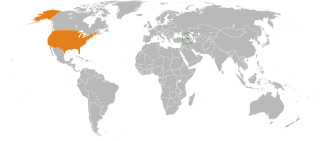
The Italian Armed Forces encompass the Italian Army, the Italian Navy and the Italian Air Force. A fourth branch of the armed forces, known as the Carabinieri, take on the role as the nation's military police and are also involved in missions and operations abroad as a combat force. Despite not being a branch of the armed forces, the Guardia di Finanza is organized along military lines. These five forces comprise a total of 340,885 men and women with the official status of active military personnel, of which 167,057 are in the Army, Navy and Air Force. The President of the Italian Republic heads the armed forces as the President of the High Council of Defence established by article 87 of the Constitution of Italy. According to article 78, the Parliament has the authority to declare a state of war and vest the powers to lead the war in the Government.
Strategy is a general plan to achieve one or more long-term or overall goals under conditions of uncertainty. In the sense of the "art of the general", which included several subsets of skills including military tactics, siegecraft, logistics etc., the term came into use in the 6th century C.E. in Eastern Roman terminology, and was translated into Western vernacular languages only in the 18th century. From then until the 20th century, the word "strategy" came to denote "a comprehensive way to try to pursue political ends, including the threat or actual use of force, in a dialectic of wills" in a military conflict, in which both adversaries interact.

Peacekeeping comprises activities, especially military ones, intended to create conditions that favor lasting peace. Research generally finds that peacekeeping reduces civilian and battlefield deaths, as well as reduces the risk of renewed warfare.
Strategic planning is an organization's process of defining its strategy or direction, and making decisions on allocating its resources to attain strategic goals.
Succession planning is a process and strategy for replacement planning or passing on leadership roles. It is used to identify and develop new, potential leaders who can move into leadership roles when they become vacant. Succession planning in dictatorships, monarchies, politics, and international relations is used to ensure continuity and prevention of power struggle. Within monarchies succession is settled by the order of succession. In business, succession planning entails developing internal people with managing or leadership potential to fill key hierarchical positions in the company. It is a process of identifying critical roles in a company and the core skills associated with those roles, and then identifying possible internal candidates to assume those roles when they become vacant. Succession planning also applies to small and family businesses where it is the process used to transition the ownership and management of a business to the next generation.
In the field of management, strategic management involves the formulation and implementation of the major goals and initiatives taken by an organization's managers on behalf of stakeholders, based on consideration of resources and an assessment of the internal and external environments in which the organization operates. Strategic management provides overall direction to an enterprise and involves specifying the organization's objectives, developing policies and plans to achieve those objectives, and then allocating resources to implement the plans. Academics and practicing managers have developed numerous models and frameworks to assist in strategic decision-making in the context of complex environments and competitive dynamics. Strategic management is not static in nature; the models can include a feedback loop to monitor execution and to inform the next round of planning.

The Partnership for Peace is a North Atlantic Treaty Organization (NATO) program aimed at creating trust and cooperation between the member states of NATO and other states mostly in Europe, including post-Soviet states; 18 states are members. The program contains 6 areas of cooperation, which aims to build relationships with partners through military-to-military cooperation on training, exercises, disaster planning and response, science and environmental issues, professionalization, policy planning, and relations with civilian government. During policy negotiations in the 1990s, a primary controversy regarding PfP was its ability to be interpreted as a program that is a stepping stone for joining NATO with full Article 5 guarantees.

Military operations other than war (MOOTW) are military operations that do not involve warfare, combat, or the threat or use of violence. They generally include peacekeeping, peacebuilding, disaster response, humanitarian aid, military engineering, law enforcement, arms control, deterrence, and multilateralism.
Civil Affairs (CA) is a term used by both the United Nations and by military institutions, but for different purposes in each case.

The Unified Task Force (UNITAF) was a United States-led, United Nations-sanctioned multinational force which operated in Somalia from 5 December 1992 until 4 May 1993. A United States initiative, UNITAF was charged with carrying out United Nations Security Council Resolution 794 to create a protected environment for conducting humanitarian operations in the southern half of the country.

In the U.S., critical infrastructure protection (CIP) is a concept that relates to the preparedness and response to serious incidents that involve the critical infrastructure of a region or the nation. The American Presidential directive PDD-63 of May 1998 set up a national program of "Critical Infrastructure Protection". In 2014 the NIST Cybersecurity Framework was published after further presidential directives.
Interim management is the temporary provision of management resources and skills. Interim management can be seen as the short-term assignment of a proven heavyweight interim executive manager to manage a period of transition, crisis or change within an organization. In this situation, a permanent role may be unnecessary or impossible to find on short notice. Additionally, there may be nobody internally who is suitable for, or available to take up, the position in question.
The foreign policy of the Bill Clinton administration was of secondary concern to a president fixed on domestic policy. He relied chiefly on his two experienced Secretaries of State Warren Christopher (1993–1997) and Madeleine Albright (1997–2001), as well as Vice President Al Gore. The Cold War had ended and the Dissolution of the Soviet Union had taken place under his predecessor President George H. W. Bush, whom Clinton criticized for being too preoccupied with foreign affairs. The United States was the only remaining superpower, with a military strength far overshadowing the rest of the world. There were tensions with countries such as Iran and North Korea, but no visible threats. Clinton's main priority was always domestic affairs, especially economics. Foreign-policy was chiefly of interest to him in terms of promoting American trade. His administration signed more than 300 bilateral trade agreements. His emergencies had to do with humanitarian crises which raised the issue of American or NATO or United Nations interventions to protect civilians, or armed humanitarian intervention, as the result of civil war, state collapse, or oppressive governments.

The Iraq War troop surge of 2007, commonly known as the troop surge, or simply the surge, refers to the George W. Bush administration's 2007 increase in the number of U.S. military combat troops in Iraq in order to provide security to Baghdad and Al Anbar Governorate.
A financial sponsor is a private equity investment firm, particularly a private equity firm that engages in leveraged buyout transactions.

The dissolution of the Soviet Union in December 1991 brought an end to the Cold War and created an opportunity for establishing bilateral relations between the United States with Armenia and other post-Soviet states as they began a political and economic transformation. The United States recognized the independence of Armenia on 25 December 1991, and opened an embassy in Armenia's capital Yerevan in February 1992.

A Responsible Plan to End the War in Iraq is a 36-page plan that was created by a group of United States Democratic congressional candidates, retired military officers and national security professionals that outlined policy measures that the candidates pledged to support in the 2008 elections.

Kosovo–Latvia relations are foreign relations between the Republic of Kosovo and the Republic of Latvia. Kosovo declared its independence from Serbia on 17 February 2008 and Latvia recognised it on 20 February 2008. Latvian and Kosovan governments established diplomatic relations on 11 June 2008. However, Latvia's involvement in Kosovo dates back to 2000 when it first sent peacekeeping troops.
Entrepreneurial finance is the study of value and resource allocation, applied to new ventures. It addresses key questions which challenge all entrepreneurs: how much money can and should be raised; when should it be raised and from whom; what is a reasonable valuation of the startup; and how should funding contracts and exit decisions be structured.
Exit planning is the preparation for the exit of an entrepreneur from his company to maximize the enterprise value of the company in a mergers and acquisitions transaction and thus his shareholder value, although other non-financial objectives may be pursued including the transition of the company to the next generation, sale to employees or management, or other altruistic, non-financial objectives. Exit planning differs from succession planning in that the later is a sub-component of exit planning, and refers to the hiring, training and retention of a successor President/CEO of the company in a planned manner. Succession Planning is but one of the many considerations when conducting exit planning. Company owners commonly do not see their company from the standpoint of a potential buyer, and thus, ignore the strategic management of the company.









